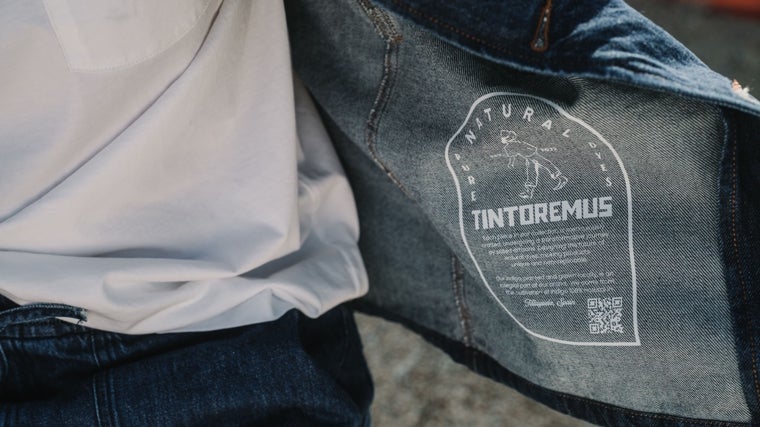Growing indigo to dress sustainability

In Santa María de Las Lomas, in the agricultural heart of Cáceres, where tobacco fields reigned for generations, a plant is also sprouting today that promises a future for the region. It is natural indigo, one of the oldest pigments in the world and the soul of a reality that goes beyond fashion: Tintoremus Studio, a company founded in 2022 with a clear purpose: to regenerate the land, dignify craftsmanship, proclaim an ode to color, and shape a different and responsible fashion, with casual yet elegant, decidedly alternative designs.
Clemente Cebrián, co-founder of the Spanish brand El Ganso, with more than 140 stores worldwide, embarked on this new adventure driven by "enthusiasm, conviction, and responsibility." He knows well what it takes to scale a brand, but also the environmental toll it takes. His partner, Lola López, a designer with a "botanical soul" and former marketing director of El Ganso, had already been researching natural dyes and questioning the excesses of industrial fashion. Together they traveled, observed, reflected, and created. "We realized we didn't have to give up color to respect the planet," Lola explains. "What we had to leave behind was haste, waste, and the throwaway logic."
It all began with a photo shoot in Jarandilla de la Vera. As they passed through Talayuela, the vast expanses of abandoned farmland reminded them of what they'd read about Kentucky and Tennessee, where farmers had successfully substituted tobacco for indigo. After experimenting with different varieties, they settled on a particularly promising one: Persicaria tinctoria. "It worked so well that we went from a small plot to cultivating 2,500 m2. And soon after, we had 10 hectares," says Clemente. Many of these plots are leased to young people in the area. "We're helping the countryside have a future. This isn't just about fashion; it's about life. Our work makes us happy, and we feel we can achieve something great, both for the region and for an industry that needs to transform."
 Cebrián observes with his team the oxygenation of the liquid rich in indica
terabithia
Cebrián observes with his team the oxygenation of the liquid rich in indica
terabithia
Unlike many brands that focus their sustainability on organic or recycled fabrics, Tintoremus has focused on an almost forgotten aspect: color. "Everyone talks about sustainability, but no one mentions dye. And dye, mostly synthetic, is one of the biggest pollutants in the textile sector," Lola points out. That's why they decided to change the logic at its roots.
The Regional Government of Extremadura quickly saw the project's potential and included it in its high-tech incubator in Mérida. "We received a lot of institutional support. They saw that it generated rural employment and diversified the agricultural economy," she emphasizes. In a short time, Talayuela is home to more than 350,000 indigo plants, the largest crop in Europe. They have also launched a system of subleasing plots for other brands. "We want designers to be able to rent small portions of land and launch capsule collections with real, local origins," Lola adds.
In a region plagued by rural abandonment, unemployment, and youth exodus, Tintoremus has revived land, created jobs, and revived forgotten knowledge. "We don't want to replace tobacco, but rather offer a complementary alternative," explains Pablo Prieto, an agricultural engineer. "Indigo is pest-free, requires no pesticides, and improves biodiversity. It's perfect for rotations that prevent soil depletion."
The pigment extraction process is clean, artisanal, and circular. "We ferment the leaves in concrete tubs, without chemicals. The water, heated by solar energy, is always reused. And we do everything alongside the crop, thus also reducing the logistical footprint," explains Clemente. Harvesting takes place two or three times a year. After cutting the plant, the leaves are immersed in water at around 30°C. There they ferment for 24 to 48 hours, releasing the coloring compounds. The plant material is then removed and turned into compost, while the liquid, now enriched with indica, is pumped into tanks where oxidation begins. Only quicklime is added as an alkalizer, and the process is manually oxygenated. Finally, the extract passes through mechanical filters that separate the indigotine. This is how the powdered pigment, indigoremus, is created. The excess water is purified and returned to the cycle, ensuring a closed and efficient system.
 Garments dyed with natural indigo, a cool new trend ideal for summer
Garments dyed with natural indigo, a cool new trend ideal for summer
And Tintoremus is more than just a cool new fashion space that's taking over Madrid. It's a continuation of the process. An interdisciplinary ecosystem where entrepreneurs, biologists, engineers, chemists, artisans, dyers, designers, and farmers coexist. "Everything is designed to minimize impact and maximize social and environmental value," says Clemente. They have a color repair and retouching workshop, a sensory indigo nursery, and a space where garments are dyed live. "We want people to understand that taking care of their clothes is also a commitment to sustainability," adds Lola. "Circularity only works if there is beauty, functionality, and a story that connects you to the garment."
Color is their hallmark. "We want to industrialize natural dye so it's no longer a rarity," says Lola. The challenge isn't dyeing a garment, but doing it on a large scale without harming the environment. That's why they use natural pigments: onion peels, pomegranate, and mulberry leaves. And their garments don't follow the frenetic pace of the industry. They are produced in limited editions, with unique pieces that dazzle with their vivid, organic colors.
Tintoremus encourages its customers to reweave, transform, or re-dye their old garments. It's not just a passing fad. It's an ethical statement. In the face of greenwashing and the trivialization of the term "sustainable," this emerging company reclaims time, craftsmanship, traceability, and roots. "We want to show that another model is possible," Lola concludes. "What's truly modern is taking care of what already exists. The most beautiful color isn't the brightest, but the one that doesn't stain the future."
ABC.es





